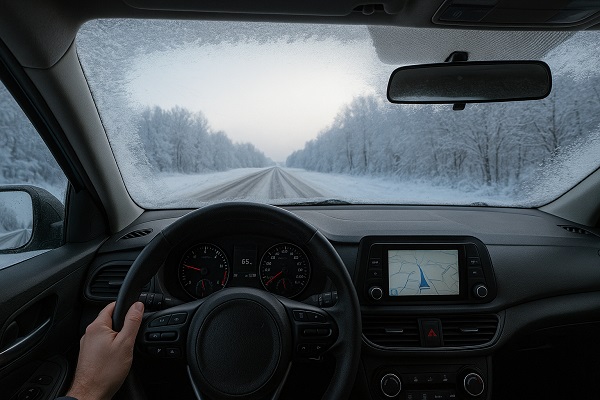Windshields play a more significant role in regulating cabin temperature than most drivers realize. As the primary barrier between the interior of a vehicle and the external environment, windshields influence how much heat enters or escapes the cabin. From material design to UV coatings, several windshield characteristics affect temperature levels inside the vehicle.
Understanding how windshields interact with sunlight, heat, and external conditions can help drivers make better decisions for comfort, energy efficiency, and overall driving experience.
How Heat Enters the Cabin
Solar Radiation and Greenhouse Effect
The primary source of heat inside a parked car is solar radiation. Sunlight passes through the windshield and is absorbed by the interior surfaces—such as the dashboard, seats, and floor mats. These surfaces then radiate the heat as infrared energy, which gets trapped inside the vehicle, causing the well-known “greenhouse effect.”
- Clear glass windshields allow a high percentage of visible and infrared light into the cabin.
- Tinted or coated windshields reduce the amount of infrared radiation, thereby lowering heat buildup.
Factors That Influence Cabin Heat Gain
- Angle and orientation of the windshield
- Geographic location and climate
- Time of day and sun intensity
- Color and material of interior surfaces
Windshield Types and Their Impact on Cabin Temperature
Standard Laminated Glass
Most vehicles come equipped with laminated safety glass for the windshield. While it’s designed for impact resistance and shatter protection, standard laminated glass does little to block infrared heat.
- Allows visible light and heat to pass through
- Can cause rapid temperature rise when parked in direct sun
Tinted Windshields
Tinted windshields include a colored layer that helps reduce glare and partially block solar heat.
- Reduces some solar gain
- Improves visibility by cutting glare
- Offers moderate temperature control
UV-Coated and Infrared-Reflective Windshields
Modern vehicles often feature windshields treated with UV coatings or infrared (IR) reflective films.
- UV coatings block up to 99% of harmful ultraviolet rays, protecting both passengers and interiors
- IR-reflective coatings significantly reduce heat transmission by reflecting solar infrared radiation
These types of windshields are especially effective in hot climates or for vehicles frequently parked outdoors.
The Role of Windshields While Driving

Air Conditioning Efficiency
A cooler cabin due to heat-reflective windshield technology means the vehicle’s air conditioning (AC) system doesn’t have to work as hard.
- Reduced fuel consumption in traditional vehicles
- Less strain on battery in electric vehicles (EVs)
- Quicker cooling times after starting the engine
Defrosting and Heating in Winter
In cold climates, windshields can also affect how heat is retained or lost from the cabin.
- Windshields with heated glass elements (defrosting lines) can clear fog or ice faster
- Insulated glass retains warmth better, reducing the time and energy needed to heat the cabin
How Much Can a Windshield Reduce Cabin Temperature?
The difference in cabin temperature can be dramatic depending on the type of windshield.
Studies and Real-World Tests
- Standard windshield: Cabin temperatures can exceed 130°F (55°C) after just 30 minutes of sun exposure.
- IR-reflective windshield: Temperatures may be 15–25°F (8–14°C) lower in similar conditions.
- UV and heat-blocking films: Can reduce solar heat gain by up to 50%
These improvements enhance comfort and protect sensitive interior materials like leather, vinyl, and plastics.
Additional Benefits of Heat-Control Windshields
Protects Vehicle Interior
Heat and UV radiation can cause dashboards, seats, and trim to crack, fade, or deteriorate over time. A windshield that reduces heat entry extends the lifespan of interior components.
Improves Safety and Visibility
Excessive glare from the sun can be a safety hazard. Tinted and coated windshields:
- Minimize visual discomfort
- Improve contrast and road visibility
- Reduce eye strain for the driver
Energy Savings
Reduced AC usage directly translates into fuel savings and lower emissions. For EVs, it contributes to better energy efficiency and extended driving range.
Aftermarket Solutions to Improve Windshield Performance
Even if your car doesn’t come with a specialized windshield, aftermarket options are available:
- Ceramic window tints: High-performance tints that block infrared and UV rays without darkening the glass excessively
- UV films: Adhesive films applied to the inside of the windshield to block harmful rays
- Reflective sunshades: Placed behind the windshield when parked to reflect sunlight and keep interiors cooler
These solutions offer affordable ways to improve cabin comfort and protect your vehicle.
Does the Windshield Affect Temperature in Cold Weather Too?

Yes, windshields can influence how quickly a cabin loses heat in cold conditions.
- Single-pane glass loses heat quickly
- Windshields with insulation or coatings retain warmth longer
- Heated windshields can speed up ice removal and reduce fogging
Though less talked about than summer heat, winter windshield performance is equally important for maintaining a stable cabin temperature.
Factors Beyond the Windshield That Influence Cabin Temperature
While the windshield is a major factor, other vehicle components also affect heat management:
- Side and rear windows: Often less protected, but aftermarket tints or shades can help
- Vehicle insulation: Thicker door and roof insulation improves thermal performance
- Interior colors: Light-colored interiors reflect heat better than dark ones
Combining a high-performance windshield with other heat-mitigation strategies results in the best temperature control.
Key Takeaways
- Windshields significantly influence how much heat enters or escapes your vehicle’s cabin.
- UV and infrared-reflective coatings can dramatically reduce cabin temperature, improve AC efficiency, and protect the interior.
- Aftermarket solutions like window films and sunshades provide budget-friendly upgrades.
- The impact of the windshield is noticeable in both hot and cold climates, affecting overall comfort and energy usage.
Whether you’re trying to stay cool in the summer or retain warmth in the winter, your windshield is one of the most important components in managing your car’s interior climate. Investing in the right type of windshield—or upgrading with aftermarket options—can lead to better comfort, efficiency, and long-term protection for your vehicle.
Content reviewed and published by SLP AutoGlass Editorial Team.

